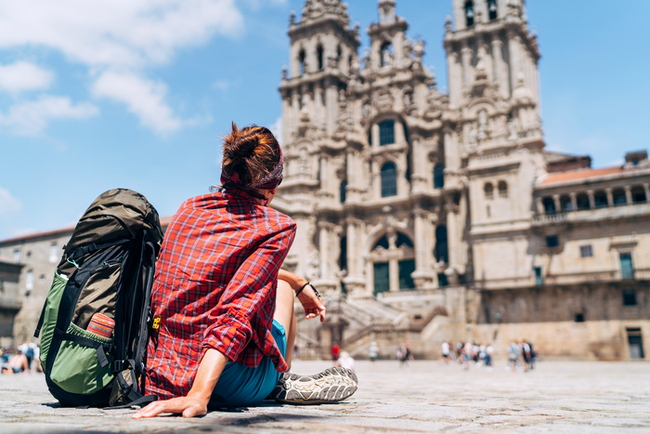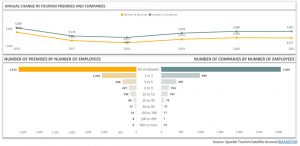Cultural Tourism Boosting the Recovery of the Sector

Cultural Tourism Boosting the Recovery of the Sector
In 2022, the movement of national tourists was similar to the figures seen in 2019. Cultural tourism represented 11% of all journeys made. The figures for visitors and spending confirm that it was the year of the sector’s recovery. Destinations such as Asturias, Murcia or the Balearic Islands exceeded the number of visitors seen in 2019, with increases of up to 74%. Santiago de Compostela also recorded very positive data, acting as a reference for religious tourism with expenditure of more than 54 million euros. Meanwhile, cultural tourism is mainly centred around Madrid, Seville, Granada and Barcelona, with spending of between 200 and 400 million euros. However, domestic tourism is not limited to national destinations, with travel abroad accounting for 50% of all journeys made.
When looking at the volume of international visitors, cultural tourism accounts for more than 17% of tourist travel during 2022, also helping to consolidate the recovery, close to 83%, although still without achieving the figures seen in 2019.
To place the figures for 2022 in the context of previous years, we have referred to the Cultural Statistics Yearbook, prepared by the Ministry of Culture and Sports, the latest edition of which contains updated data for 2021, including the analysis of the changes in cultural tourism. With this in mind, the data reflects a considerable increase in tourist activity in the cultural sector compared to 2020, placing the recovery at 80.5% for domestic tourism and 36.3% for international visitors. However, in comparison to 2019, before the onset of the pandemic, these figures are still notably down by 49.5% and 69%, respectively.
In the same report, it is indicated that trips on cultural grounds accounted for 12.4% of domestic travel and 17% in the case of international visitors, receiving, combined, more than 13 million visitors, with cultural spending of more than 3,500 million euros in relation to domestic tourism and more than 5,000 million for international visitors. Domestic tourism is mainly concentrated in national destinations, accounting for up to 80%, while 17.8% name European countries as the second reference destination.
Increased Impact of Cultural Tourists
90% of cultural tourists are very satisfied with their visit and more than 30% did not report any shortcomings, leading to the rapid recovery of tourist spending to levels even higher than those seen in 2019, across the main national tourist destinations. Religious tourism involving international visitors saw an increase in spending of 5% during the past year, improving by 12% when it comes to international cultural tourists.
World Heritage Cities benefitted particularly and in 2022 they once again saw an improvement in the profitability of their hotel sector. They are considered as a sample of the catalyst effect that these cities have in their regions, providing returns close to 40% higher than the average, both at a local and regional level.
Furthermore, the price per room in World Heritage Cities is higher than the region in which they are located, by up to €15 and generate estimated income of €21 more, with a degree of use that is almost twice the figures seen at local and regional levels. However, one notable difference can be seen in the profitability of hotel accommodation achieved by some cities, with almost 20% higher use compared to other destinations recognised as being of World Heritage.
This increase in spending associated with cultural tourism has had a stabilising effect on the economy of cultural tourism, which accounts accounts for an employability volume of 11.40% of the total, with 2,274 workers registered in 2021. The impact of the cultural activities accounts for 10% of the impact of artistic activities and shows and is less than 1% in relation to the total number of venues and companies that dedicate their activity to tourism.
In relation to other specialties in the tourism field, cultural tourism venues and companies are mainly constituted by self-employed workers. The presence of companies and premises made up of 6 or more workers is also above average.
The figures shows how cultural tourism has overcome the 2020 crisis, which not only has not resulted in a decrease in the number of entities performing activities in this field, but, in the case of the number of companies, their number has increased.
Consolidation of the Sector in a Global Situation of Uncertainty
the Camino de Santiago or the World Heritage Cities, have seen their position strengthened. This phenomenon seems to point to the slower recovery of the volume of international visitors during 2021 and 2022.
As part of this recovery process, there has also been an increase in cultural tourism spending, particularly noteworthy in relation to religious and pilgrimage tourism, as a result of longer holiday periods and the demand for higher quality and safer services, resulting in greater visitor satisfaction. As part of this increase in spending, the effect of inflation, which has played a significant role, cannot be overlooked.
Both cultural tourism and religious or pilgrimage tourism have experienced the strongest recovery among international visitors, followed by business, study and leisure tourism. In relation to domestic tourism, the recovery of business tourism is worth particular mention, followed by cultural tourism, while religious tourism, gastronomic, shopping, well-being and sports tourism are lower down the pecking order.
In relation to the sector’s impact on employability, a process of consolidation and stability is foreseen, following a previous period in which there was a slight decline. The self-employed and SMEs and micro-SMEs continue to be the stakeholders supporting the sector’s commercial activity.



